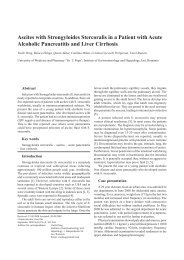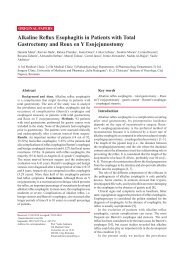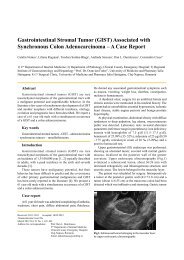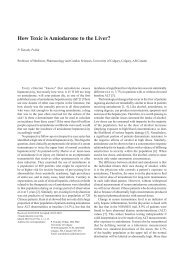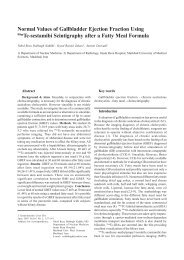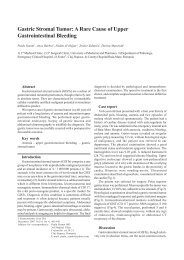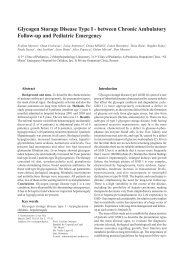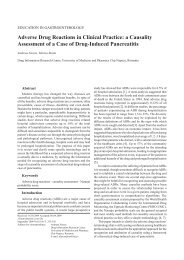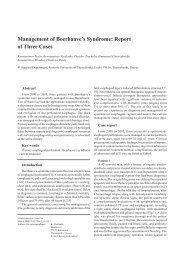download Full Article (PDF file) - Journal of Gastrointestinal and ...
download Full Article (PDF file) - Journal of Gastrointestinal and ...
download Full Article (PDF file) - Journal of Gastrointestinal and ...
Create successful ePaper yourself
Turn your PDF publications into a flip-book with our unique Google optimized e-Paper software.
Irritable bowel syndrome <strong>and</strong> spasmolytics 19<br />
temporal occurrence as well as the very specific features <strong>of</strong><br />
the propulsive waves. Segmenting contractions featured low<br />
amplitude waves <strong>and</strong> were non-propagating. Specific features<br />
<strong>of</strong> peristaltic waves included their distal propagation, high<br />
amplitude <strong>and</strong> intermediate duration. Propulsive waves were<br />
rare, related, perhaps to the prior cleansing <strong>of</strong> the rectum but<br />
were very distinctive being <strong>of</strong> high amplitude, long duration<br />
(approx 30 sec) <strong>and</strong> distinctly propagative. These waves<br />
correspond to the high amplitude propagating contractions<br />
or power contractions described by others.<br />
In evaluating motor activity, the following values were<br />
defined:<br />
a. The magnitude <strong>of</strong> the tone <strong>of</strong> intestinal wall, calculated<br />
using the formula Tone = 1/ A, where A is amplitude <strong>of</strong><br />
respiration waves, expressed in mmHg;<br />
b. The median amplitude <strong>and</strong> duration <strong>of</strong> individual<br />
waves <strong>of</strong> motor activity;<br />
c. Longitudinal relationships between wave forms (i.e.<br />
whether segmenting, peristaltic or propulsive);<br />
d. The index <strong>of</strong> motor activity calculated using the<br />
formula:<br />
Index = ∑ A x t / T , where A = amplitude <strong>of</strong> wave, t =<br />
duration <strong>of</strong> the wave, T = the duration <strong>of</strong> the period <strong>of</strong><br />
recording registering <strong>and</strong> ∑ = sum <strong>of</strong> A x t<br />
e. Timing <strong>and</strong> intensity <strong>of</strong> the 1 st <strong>and</strong> 2 nd phases <strong>of</strong> the<br />
gastro-colonic reflex.<br />
Statistics<br />
For comparisons pre- <strong>and</strong> post-treatment, within a given<br />
group Student’s t-test or Wilcoxon <strong>and</strong> Mann-Whitney U<br />
tests were used, for parametric <strong>and</strong> non-parametric data,<br />
respectively. Where multiple comparisons were performed,<br />
the Bonferroni correction was used.<br />
Results<br />
All 96 subjects who entered the r<strong>and</strong>omization phase<br />
completed the two-week study (Table 1); there were no<br />
drop-outs relating to adverse events or otherwise <strong>and</strong>,<br />
indeed, no side effects were reported in relation to any <strong>of</strong><br />
the therapies.<br />
1. Baseline symptoms <strong>and</strong> response to treatment<br />
(Table I)<br />
As expected, the highest pain scores were recorded at<br />
baseline by those IBS patients with predominant pain <strong>and</strong><br />
bloating. On the visual analog scale, the average intensity<br />
<strong>of</strong> pain at baseline was estimated by IBS patients with<br />
predominant pain <strong>and</strong> bloating at 13 (on a scale whose<br />
maximum was 20 points), by IBS patients with predominant<br />
diarrhea at 10 points <strong>and</strong> by IBS patients with predominant<br />
constipation at 8 points.<br />
Significant reductions in pain score were achieved<br />
only among IBS patients with predominant diarrhea <strong>and</strong> in<br />
response to either oral or per suppository buscopan.<br />
2. Rectal sensation<br />
a. Baseline studies<br />
In the control group, the threshold for the development<br />
<strong>of</strong> discomfort/pain was 43.6±3.2 mm Hg which corresponds<br />
closely to previous reports [6]. In the IBS patients, the<br />
threshold for the development <strong>of</strong> discomfort/pain was<br />
significantly lower at 24.08 mmHg. Differences in<br />
discomfort/pain threshold were also evident between the<br />
IBS subgroups, being significantly (p0.05<br />
32.61±5.08 35.4±2.6 p>0.05<br />
21.78±2.8 39.60±2.4 p




